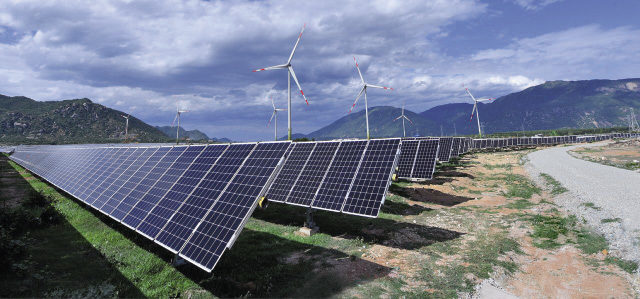Drawing on the flexibility of the Arctech Solar product portfolio, the company has developed several new projects around the world. These new projects add to the 19 GW of global installations that Arctech Solar has already worked on with each of its solar mounting system technologies.
Benjamin Hill Solar
Among the many regional markets where Arctech has made inroads, one recent first for the company was the $130 million Infrastructura Energética Nova project at Benjamin Hill, in Sonora, Mexico. It supported the 167 MW array with its SkySmart technology.
“After evaluating different tracker suppliers and models, we concluded that Arctech’s two-in-portrait system would provide a better fit in terms of optimization of space,” said Ivan Lopez, project manager at IE Nova, which developed the project. “This capability enabled us to have a portion of the project crossing a gas pipeline and a transmission line. Another benefit of the design enabled us to avoid current induction interference typically produced by the direct current cathodic protection system.”
Arctech Solar provided the IE Nova team with on-site consultants, spanning the duration of the project, from pre-delivery through construction. Power from the facility will be provided to Mexican department store chain El Puerto de Liverpool under a 15-year power purchase agreement.
Serving as a blueprint installation in Mexico, the World Bank’s private sector investment arm, International Finance Corp. (IFC), is considering a loan of several hundred million dollars for a group of model IE Nova solar projects, including the Benjamin Hill installation. The multilateral loan will likely help developers of other large-scale solar projects like Benjamin Hill.
Mobilong Solar Farm
Arctech Solar provided its 1P SkyLine horizontal tracker solution to the 5 MW Mobilong solar project in Australia for Balance Utility Solutions. It was Arctech’s first successfully commissioned project in Australia, and involved customized engineering to optimize the site.
“The approach for this project was to limit the amount of preparatory civil works required to construct the system. For smaller site footprints a tracking system is often necessary to meet energy yield targets, so having Arctech Solar’s independent tracking systems – with the flexibility to handle undulatory land conditions and an appreciable gradient – helped minimize cut and fill costs for this project,” says Jake May, an electrical engineer for Balance Utility Systems.
SkyLine’s self-powered array features also helped to limit the cost of trenching and cabling. “A self-powered tracking system makes good sense from a material and installation perspective, as generally less cable is required in comparison to tracking systems dependent upon a reticulated power supply,” notes May.
Integrating solar and wind
In yet a third technology application, Arctech Solar supplied the 258 MW Trung Nam solar array in Vietnam with a combination of SkyLine and fixed structure designs. The project involved pairing PV with existing wind generators at a seaside site with land constraints.
“We opted to deploy the best combination of trackers and fixed structures to ensure we met the land-use requirements of the Vietnamese government,” said Tam Tien Nguyen, CEO of Trungnam Group. “The energy production of the combined trackers and fixed structures will increase overall yield by up to 26%.”
Arctech Solar was asked to develop the site layout to avoid any shading of the solar array by the wind generators, while still fitting the solar PV project into a small footprint of usable land. By optimizing the squeezed site with a tracker layout solution, Arctech Solar maximized the output. Overall, the project included more than 70,000 solar panels and 45 wind turbines.
“We were cautious to select suppliers for this key equipment. We believe this project will have higher economic returns compared with fixed mounting structures by adopting the Arctech innovative SkyLine tracking system,” Nguyen said.
Apart from sourcing enough firm soil for the development of the project location, another site-specific precaution was the use of anti-corrosion, pre-galvanized steel to protect the structure from the salty environment. The project is the first wind and solar hybrid integration in the country, and the largest renewable energy development in Vietnam.
This content is protected by copyright and may not be reused. If you want to cooperate with us and would like to reuse some of our content, please contact: editors@pv-magazine.com.
